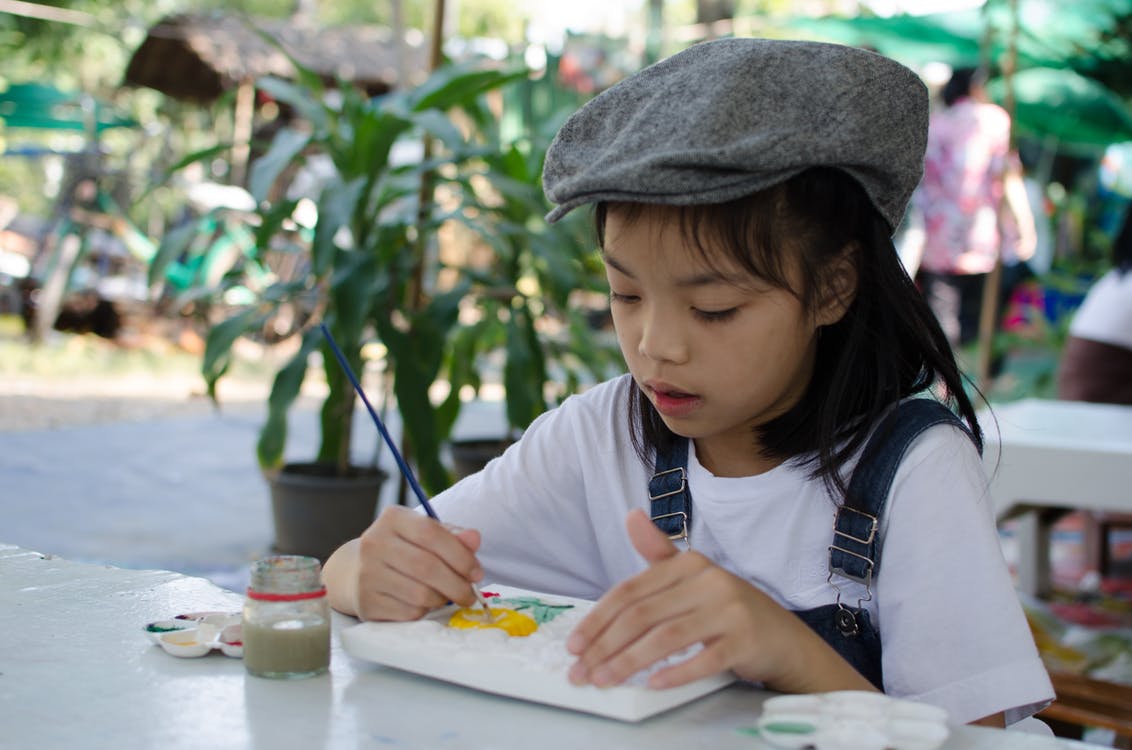Developing Responsibility: How Pets Teach Children Valuable Life Skills
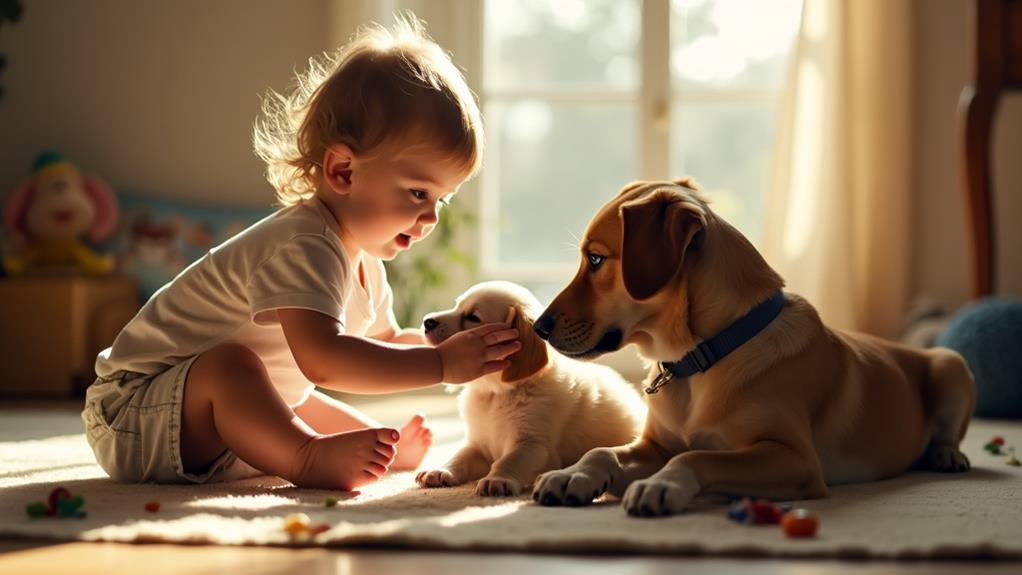
Introducing a pet into your child's life offers more than just companionship; it provides crucial lessons in responsibility. Tasks like feeding and grooming instill the importance of daily routines and reliability. These activities serve as practical opportunities for children to understand the consequences of neglect and the rewards of commitment, fostering accountability and prioritization skills. But how do these lessons extend to broader life skills, and what specific benefits can you expect?
Learning About Animals

Learning about animals through pet care enables children to understand different species and their unique needs. Caring for pets imparts essential life skills, making the experience both enjoyable and educational. For instance, maintaining a fish tank teaches children about water quality and the basics of aquatic life, offering a hands-on learning opportunity.
If your child has a reptile, they can learn about cold-blooded animals and their specific environmental requirements, potentially fostering an interest in biology and the natural world. Engaging with pets also encourages children to discover interesting facts about various species, enriching their knowledge of wildlife and animal behavior.
Tasks like feeding and cleaning pets emphasize the importance of consistency and care, highlighting how schedules are vital for living beings. Observing pets' behaviors enhances their understanding of animal interactions, contributing to a broader comprehension of ecosystems and biodiversity. Through pet care, children learn to appreciate life's complexities and the diverse needs of different species.
Developing Accountability
Caring for a pet profoundly influences a child's sense of responsibility. When pets require daily attention, children learn the significance of consistent actions. Tasks like feeding, grooming, and exercising pets go beyond simple chores; they are practical lessons in accountability. By managing these responsibilities, children learn to prioritize their pets' needs, fostering a strong sense of duty.
Daily pet care helps children grasp the concepts of reliability and the consequences of neglect. When they ensure their pets are fed on time or properly groomed, they observe the direct impact on their pet's health and happiness. This teaches them the importance of being dependable and the immediate effects of their actions.
| Task | Pet's Need | Child's Responsibility |
|---|---|---|
| Feeding | Nutrition | Regular meal times |
| Grooming | Cleanliness | Regular brushing/bathing |
| Exercising | Physical activity | Daily walks/playtime |
| Health Check | Well-being | Regular vet visits |
Emotional Intelligence
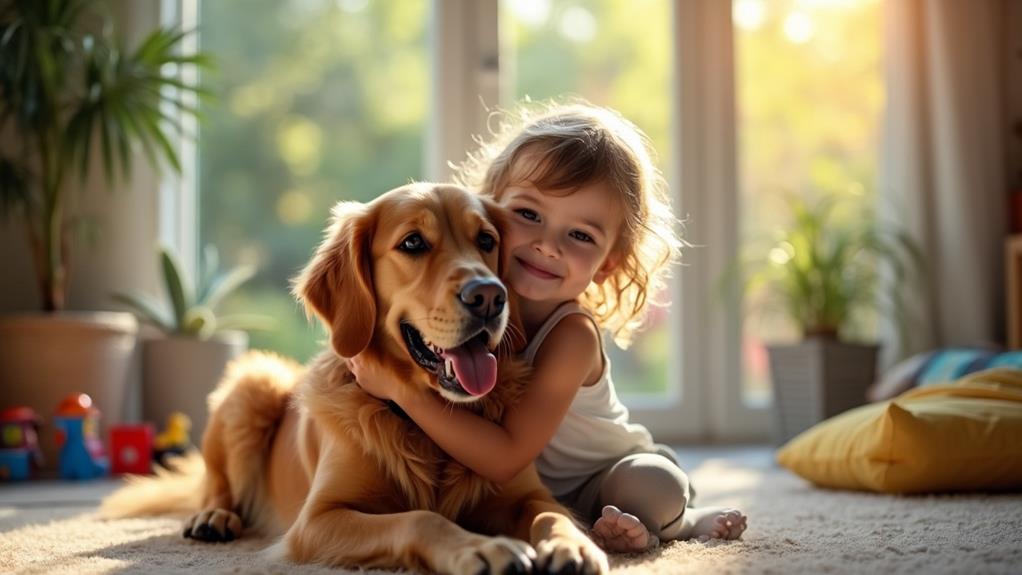
When children interact with pets, they enhance their ability to recognize and respond to non-verbal cues, significantly boosting their emotional intelligence. By observing and understanding an animal's body language and expressions, kids learn crucial lessons about empathy and compassion. These skills are transferable to their interactions with people, making them more attuned to others' emotions and needs.
Caring for pets requires children to be sensitive to their furry friend's feelings. This responsibility fosters empathy, as they must interpret how their pet is feeling and respond appropriately. Over time, this practice improves their social skills, making them more tolerant and accepting of diverse perspectives and emotions in human relationships.
Research indicates that children with pets often exhibit better social interactions and emotional resilience. Positive interactions with pets provide emotional support, helping kids manage stress and anxiety. The sense of security and stability pets offer can bolster a child's confidence and self-esteem. Experiencing unconditional love from a pet reinforces their emotional well-being, aiding them in forming healthier relationships with others.
In essence, the bond between children and pets nurtures emotional intelligence, equipping them with the empathy and compassion needed for enriched social connections.
Companionship and Activity
Pets provide reliable companionship for children, significantly reducing loneliness. Interacting with pets teaches kids to share and communicate, enhancing social skills. Additionally, these interactions encourage an active lifestyle, promoting both mental and physical well-being.
Reliable Playmates for Kids
While every child needs a friend, sometimes the best companions come with fur and four legs. Pet ownership provides children with reliable playmates who offer constant companionship, reducing feelings of loneliness and fostering a sense of belonging. Playing with pets not only generates fun but also helps children develop essential social skills, improving their communication and ability to form strong bonds.
Regular activities with pets, such as walking or playing fetch, promote physical health and well-being by encouraging an active lifestyle. These activities get kids moving and exploring the outdoors, which is beneficial for both their physical and emotional health. The presence of a pet can also alleviate anxiety and depression, offering emotional support through their unwavering companionship and playful antics.
Pets inspire children to engage in both indoor and outdoor activities, nurturing a love for exploration and physical exercise. Whether it's a game of tug-of-war or an adventurous walk in the park, these interactions keep children engaged and help them stay physically and emotionally healthy. Thus, a pet can be an ideal, dependable playmate for your child.
Encourages Social Interaction
Ever considered how pets can revolutionize a child's social life? Pets teach children essential lessons about companionship and interaction. When kids engage with pets, they participate in activities like walking, playing fetch, or grooming. These activities not only promote physical health but also provide opportunities for kids to meet other pet owners and their children. Through these shared experiences, kids learn to communicate and bond with their peers, fostering friendships.
Pets help children develop crucial social skills, such as patience and empathy. Taking care of a pet instills a sense of responsibility and an understanding of the pet's needs, which can translate into better interactions with people. Engaging in pet care routines also encourages teamwork within the family, as everyone shares the responsibilities and joys of pet ownership.
In essence, pets serve as social catalysts. They provide companionship and create environments where kids can comfortably interact with others. By involving pets in daily activities, you help your child build a strong foundation of social skills that will benefit them throughout their lives.
Reduces Loneliness Significantly
Feeling lonely can be particularly challenging for children, but having a pet can make a significant difference. Pets provide unwavering companionship, greatly reducing feelings of loneliness and enhancing children's emotional well-being. When a child feels isolated, a pet's presence can offer comfort and a sense of belonging that is hard to find elsewhere.
Engaging in activities like walking or playing with pets can help reduce loneliness by fostering social interaction and strengthening emotional bonds. These shared experiences make children feel more connected and supported. Studies show that children with pets often report feeling less isolated and more resilient, contributing to better mental health.
Moreover, pets can help ease anxiety and depression symptoms. They offer a sense of purpose and companionship, making children feel less abandoned. This emotional support is invaluable, providing a reliable source of comfort and stability.
Pets also encourage children to engage in physical activities, both indoors and outdoors, promoting physical health and expanding their social circles, as pets often attract attention and interaction from others. Overall, pets can help children develop valuable life skills while significantly improving their emotional well-being.
Volunteering With Pets
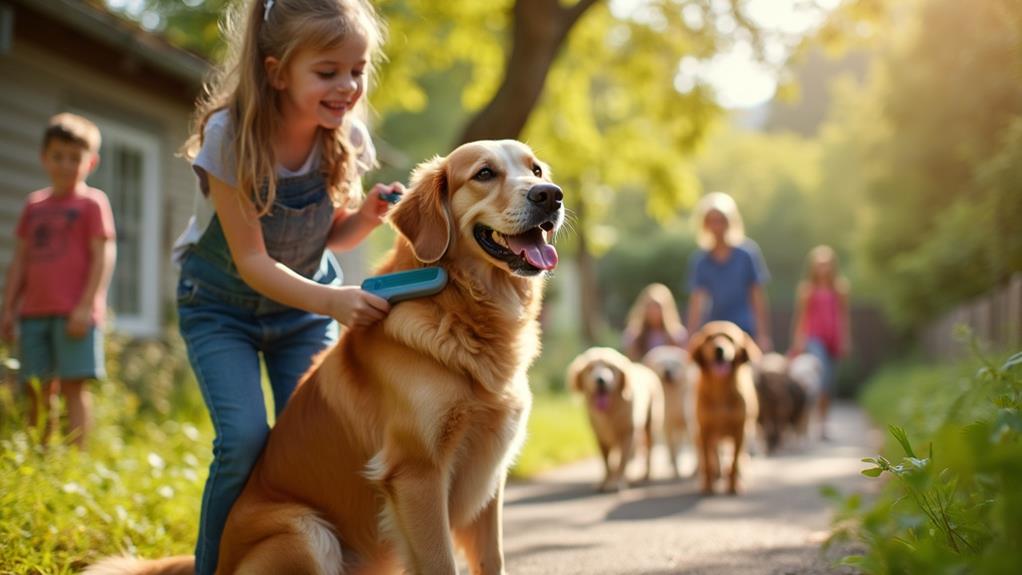
Getting your child involved in volunteering at animal shelters helps them build compassionate relationships with animals in need. They'll enhance their community engagement through activities like reading to shelter pets and walking dogs. These experiences teach valuable life skills, foster a sense of responsibility, and cultivate empathy.
Building Compassionate Relationships
Volunteering with pets at animal shelters provides children with a unique opportunity to develop compassionate relationships and essential life skills. By caring for animals in need, children learn to interpret and respond to non-verbal communication and emotional cues, fostering empathy and compassion. This hands-on experience with pets emphasizes the importance of kindness and patience.
Three key benefits of volunteering with pets include:
- Enhanced Reading Skills: Participating in reading programs at shelters allows children to practice reading aloud in a supportive environment. Pets, as attentive listeners, help boost children's confidence and reading fluency.
- Sense of Responsibility: Walking shelter dogs not only provides crucial exercise for the animals but also teaches children about responsibility and commitment. They learn the importance of maintaining a routine and experience the joy of positively impacting another living being.
- Teamwork and Cooperation: Engaging in community activities related to animal care fosters a sense of teamwork. Children collaborate with other volunteers, learning the value of cooperation and collective effort in supporting animal welfare initiatives.
Enhancing Community Engagement
Engaging with the community through volunteering at animal shelters provides a multifaceted learning experience for children. When children participate in these activities, they gain hands-on experience in caring for animals, which fosters responsibility and empathy. Programs like reading to shelter dogs can enhance children's reading skills and boost their confidence, creating a supportive environment where children feel appreciated by the attentive animals.
Walking shelter dogs is another excellent volunteering activity. It not only provides essential exercise for the dogs but also promotes physical activity and responsibility in children, reinforcing the importance of regular care routines and commitment in caregiving roles.
Community programs involving pet care also encourage teamwork and social interaction. Children often collaborate with other volunteers to fulfill animal care responsibilities, helping them understand the value of working together towards a common goal.
Volunteering with pets can serve as an alternative to pet ownership, allowing children to develop empathy and responsibility without the long-term commitment, thus providing a balanced approach to learning vital life skills.
Life Skills From Pets
Children can gain invaluable life skills through the daily care and companionship of pets. By taking on responsibilities such as feeding, walking, and grooming, kids quickly learn the importance of routine and commitment. This daily care routine not only ensures the pet's well-being but also instills a strong sense of accountability in children.
Recognizing and responding to their pets' non-verbal cues and emotional states helps kids develop empathy. They learn that their actions directly impact the well-being of another living creature, fostering compassion and enabling them to build stronger emotional connections with others.
Engaging in pet care tasks, like cleaning up after animals or training them, also enhances problem-solving skills. Kids learn to address challenges and find effective solutions, whether it's figuring out the best way to train a puppy or managing a pet's health needs.
Here are three key life skills that kids learn from pets:
- Responsibility: Daily pet care teaches commitment and routine.
- Empathy: Understanding and responding to pets' needs fosters compassion.
- Problem-solving: Managing pet care challenges improves critical thinking.
Through these experiences, children develop crucial skills that benefit them throughout their lives.
Physical and Emotional Benefits

Engaging with pets regularly enhances children's physical health by promoting active lifestyles. Activities like walking the dog or playing fetch keep kids moving, improving their fitness and overall well-being. These daily routines also instill a sense of responsibility.
Beyond physical benefits, pets provide significant emotional support. When children feel stressed or anxious, a pet's unconditional love offers comfort. Pets help alleviate feelings of loneliness or insecurity, fostering a sense of security and love. This emotional bond often boosts self-esteem as children appreciate their pets' unwavering affection.
Caring for a pet can also enhance emotional intelligence. Kids learn to interpret non-verbal cues, like a wagging tail or purring, helping them better understand and respond to emotions in others. This skill can lead to stronger interpersonal relationships.
Interestingly, growing up with pets can strengthen children's immune systems. Early exposure to the microorganisms pets carry may result in fewer infections and allergies.
Age-Appropriate Tasks
Assigning age-appropriate tasks to children when caring for pets guarantees they learn valuable life skills without feeling overwhelmed. By matching tasks to their developmental stage and maturity, children can effectively learn responsibility while meeting their pets' needs.
For children under 4:
- They should be closely supervised and can assist with simple tasks like petting the animal or observing feeding routines. These activities gently introduce them to the concept of responsibility.
For kids aged 5 to 10:
- With guidance, they can take on more structured responsibilities. Helping to feed pets and refilling water bowls are suitable tasks that teach accountability and the importance of routine in pet care.
For children older than 10:
- They are ready for more independent tasks such as walking dogs, cleaning up after them, and participating in grooming routines. These responsibilities help them develop a deeper sense of accomplishment and the ability to manage tasks autonomously.
Key Developmentally Appropriate Tasks:
- Under 4: Petting and observing feeding routines.
- Ages 5-10: Feeding pets and refilling water bowls.
- Older than 10: Walking dogs, cleaning up, and grooming.
Choosing the Right Pet
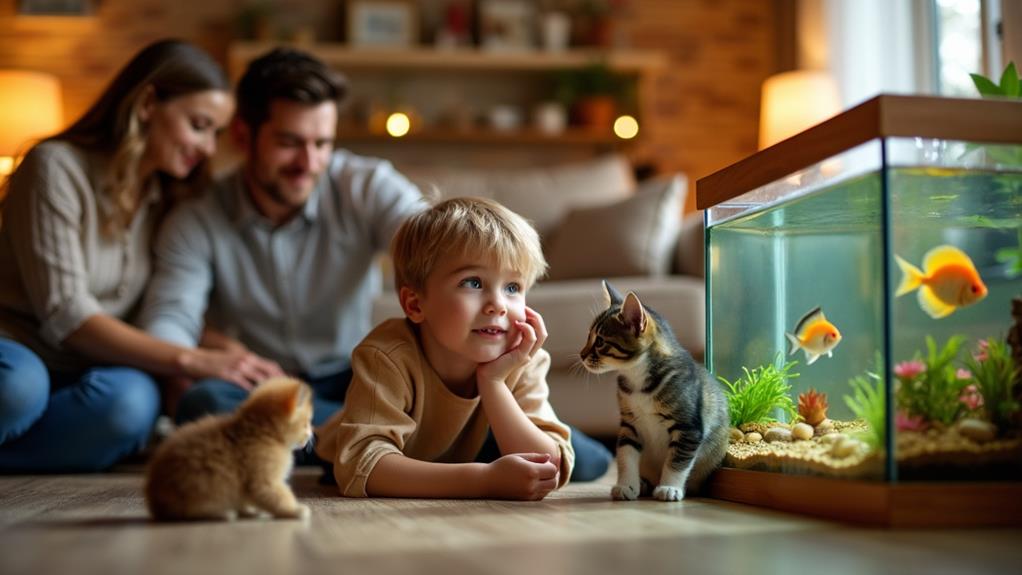
When selecting a pet, consider your lifestyle and the level of care different animals require. If your household is busy, low-maintenance pets like fish or hamsters may be suitable. Conversely, an active family might benefit from a dog that can join in outdoor activities.
Research the long-term commitment required for various pets. Animals like parrots and turtles can live for decades, necessitating ongoing care and resources. Ensure you're prepared for this level of dedication before making a decision.
Evaluate the maturity and capabilities of your children. Younger kids, around 5 years old, can manage simple tasks like filling water bowls, fostering a sense of responsibility. Older children, around 10 and up, can handle more complex duties such as feeding and walking pets, enhancing their independence.
Utilize resources like local animal shelters or pet care guides to understand different animals' needs and characteristics. This ensures the pet you choose fits well with your family's dynamics and helps children develop valuable life skills through pet ownership.
Problem-Solving Skills
When your pet has behavioral issues, your child learns to identify the causes and find solutions, enhancing their problem-solving skills. Choosing appropriate toys for your pet based on its size and activity level helps your child practice decision-making and evaluate options. These activities teach children to think critically and creatively, preparing them for real-life challenges.
Addressing Behavioral Challenges
Addressing behavioral challenges in pets offers children a valuable opportunity to enhance their problem-solving skills. When a dog acts out, kids can practice critical thinking by identifying root causes such as anxiety or boredom. Involving them in pet care and training helps develop essential skills. Here's how:
- Identify the Problem: Children can observe their pet's behavior to identify issues. Is the dog chewing on furniture out of boredom, or acting anxious due to a new environment? Analyzing these factors promotes analytical thinking.
- Develop Solutions: Encourage kids to brainstorm solutions, like changing the dog's routine, introducing new toys, or increasing exercise. These efforts teach them to create and implement strategies effectively.
- Teamwork and Collaboration: Working with their pet in training sessions fosters teamwork. Kids learn the importance of communication and joint effort, which are invaluable life skills.
Decision-Making With Toys
Understanding behavioral challenges is just one way pets help kids develop vital life skills. When selecting toys for pets, children engage in decision-making that is both practical and educational. Assessing a pet's size, age, and breed requires critical thinking, as kids must determine which toys are safe and appropriate. This process enhances their ability to prioritize safety features and durability, ensuring they make quality choices.
Observing how pets interact with different toys sharpens children's observational skills. They learn to adapt their decisions based on real-time feedback, recognizing that some toys may be more appealing or safer than others. This hands-on problem-solving approach helps kids become more intuitive and responsive to their pet's needs.
Involving children in the selection and rotation of pet toys fosters teamwork. As they discuss and negotiate which toys to choose, they practice communication and collaboration, essential skills for any group activity. Through this process, kids learn that decision-making often involves considering multiple perspectives and working together to find the best solution. By participating in these activities, children develop a well-rounded set of life skills that extend beyond pet care.

